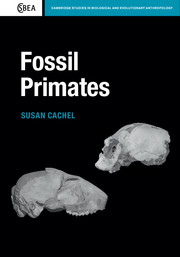Book contents
- Frontmatter
- Dedication
- Contents
- Acknowledgments
- Preface
- 1 Introduction: primates in evolutionary time
- 2 Primate taxonomy
- 3 Fossils and fossilization
- 4 The world of the past
- 5 The lifeways of extinct animals
- 6 Evolutionary processes and the pattern of primate evolution
- 7 Primate origins
- 8 The Paleocene primate radiation
- 9 The Eocene primate radiation
- 10 The Malagasy primate radiation
- 11 The Oligocene bottleneck
- 12 Rise of the anthropoids
- 13 The platyrrhine radiation
- 14 The Miocene hominoid radiation
- 15 The cercopithecoid radiation
- 16 Late Cenozoic climate changes
- 17 Conclusions
- References
- Index
13 - The platyrrhine radiation
Published online by Cambridge University Press: 05 April 2015
- Frontmatter
- Dedication
- Contents
- Acknowledgments
- Preface
- 1 Introduction: primates in evolutionary time
- 2 Primate taxonomy
- 3 Fossils and fossilization
- 4 The world of the past
- 5 The lifeways of extinct animals
- 6 Evolutionary processes and the pattern of primate evolution
- 7 Primate origins
- 8 The Paleocene primate radiation
- 9 The Eocene primate radiation
- 10 The Malagasy primate radiation
- 11 The Oligocene bottleneck
- 12 Rise of the anthropoids
- 13 The platyrrhine radiation
- 14 The Miocene hominoid radiation
- 15 The cercopithecoid radiation
- 16 Late Cenozoic climate changes
- 17 Conclusions
- References
- Index
Summary
South America has had a strange biogeographic history. It was literally an island continent for most of the Tertiary. This is because the last land connection between Africa and South America was lost in the Middle Cretaceous (about 105 mya), and the South American connection with Antarctica—and hence the South American connection with Australia—was lost in the Late Cretaceous (about 80 mya). Central America did not yet exist, and only gradually came into being after a complicated succession of increasingly larger volcanic island arc systems finally culminated in the current land mass. The Isthmus of Panama did not form a complete land bridge between North and South America until 3.5 mya. The “splendid isolation” of South America yielded a unique fossil mammal history with peculiar ecosystems in which carnivorous marsupials and giant flightless birds preyed on a unique array of placental ungulates. Deciphering the fossil history of South America became a major research subject for vertebrate paleontologists investigating convergent evolution within long-separated lineages of marsupial and placental mammals (Scott, 1937; Simpson, 1980, 1984; Flynn, 2009).
Habitats in South America are also affected by strange types of forest vegetation, such as the narrow, tall Araucaria trees (Family Arucariaceae), whose leaves form tight spirals at the end of branches (Figure 13.1). These trees are otherwise found in Australia. Forests of southern beech (Nothofagus) are also characteristic of tropical and temperate forests in southern South America. There are almost 40 species in the genus, which is classified as a separate family (Family Nothofagaceae). Members of this genus are found throughout the South Pacific Rim, including Australia, Tasmania, New Guinea, and New Zealand. Fossils of southern beech are found in Antarctica. These Nothofagus forests were once found throughout the ancient landscape of the Gondwana continent, before plate tectonic movements tore the continent apart. The lowland tropical rainforests of Amazonia are now a major feature of the modern Neotropics, but their range has drastically expanded and contracted with Pleistocene climatic fluctuations. Archaeological evidence indicates that pre-contact Amerindians extensively altered the Neotropical rainforests through sophisticated agro-forestry, and so the current expanse of lowland tropical rainforests was apparently much different even as late as A.D. 1491.
- Type
- Chapter
- Information
- Fossil Primates , pp. 195 - 213Publisher: Cambridge University PressPrint publication year: 2015



